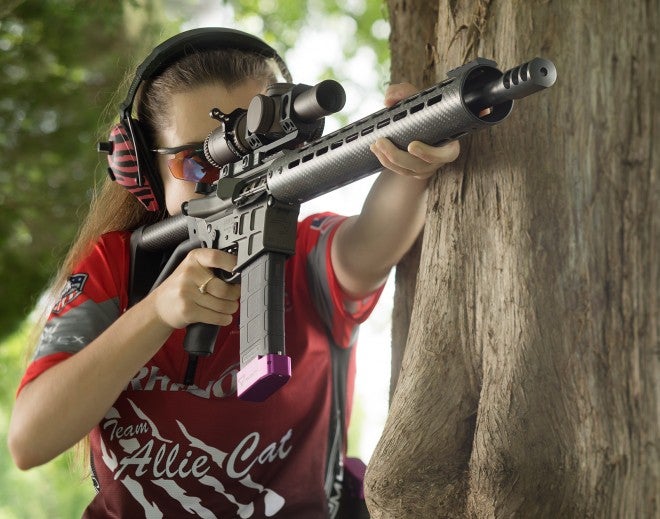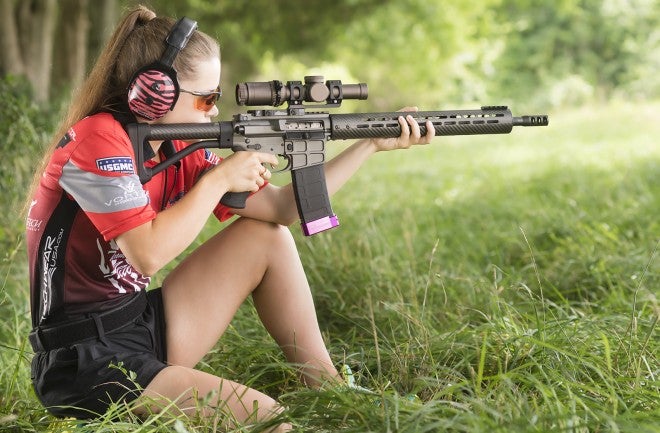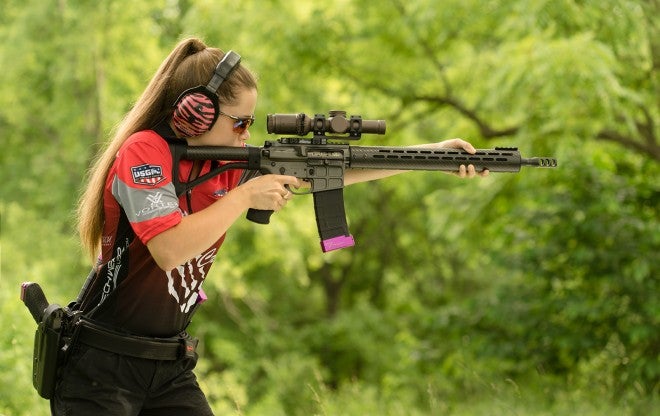Competition Rifles: Bringing the Point of Balance Back
Oleg Volk 06.22.15

Unlike service rifles, which are usually issued in standard, pre-set configurations to all users, personal weapons can be customized for best fit. One of the most important elements of the fit is balance. A typical AR15A2 has a 20 inch heavy barrel and a light plastic forend with stamped heat shields. Despite the lightweight forend, that rifle is fairly front-heavy with the center of balance further removed from the shooter by the long stock. That works great for deliberate long-range fire from supported positions as the rifle moves very little on recoil.

The rifle shown here was built by AP Rhino for Cheyenne Dalton, a 3-gun shooter. Although quite athletic, Cheyenne is still a 5’2″ 14 year old girl, and her reach and strength aren’t up to the USMC standards. So the rifle comes with a very short fixed stock and a carbon fiber forend to save weight and move the center of balance aft. Yet after all this effort, the balance is restored further forward by the weight-saving cutaways on the receiver and lighter than usual bolt carrier group. Since 3-gun stages involve some longer shots and rapid strings of fire, the barrel cannot be reduced in diameter too much without heat-related issues popping up. Unlike metal handguards, carbon fiber doesn’t conduct heat readily, so the support hand remains safe even after the barrel warms up. Since the material dampens vibrations better than metal, the shooter can even place the forend directly on barriers for support without suffering nearly as much shift in point of impact as with metal free-float tubes.
In its stage-ready trim, this rifle is balanced quite further back than its looks would suggest. Don’t forget the weight of the optic: good, bright glass in a tough tube weighs quite a bit! In this case, Vortex 1-6×24 with rings and mount approached 30 ounces! That’s more than enough to set the balance to fit the young shooter and, incidentally, why light rifles are preferred by so many shooters. The rifle itself is only one of many components of the weapon, and any weight saved in its build can be used for ammunition or accessories.
Since there’s no free lunch in gun building, the favorable balance comes at the cost of increased muzzle rise upon firing. That’s mitigated in part by the effective muzzle brake and in part by technique. Here, Cheyenne shows the far forward grip, which both weighs down the front on the rifle with her hand and pulls the stock into her shoulder. That, of course, defeats the point of having the muzzle-light rifle, but only temporarily. This hold works great for a quick close-distance stage, both to hold the muzzle down and to guide it rapidly towards the next target, while a more orthodox hand placement ensures steadiness for longer shots. My own expedient for reducing muzzle rise would have been to employ hasty sling, but few 3-gun shooters use slings at all.
A similar balance can be achieved with more conventional materials and configuration–some high-power shooters just used the AR15A2 with lead added to the buttstock trap–but the overall weight would have been noticeably greater. While a big heavy rifle isn’t a big deal for a tall, strong Marine, the rest of us might like the option to wimp out and still be on target with effect.


